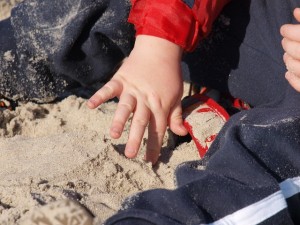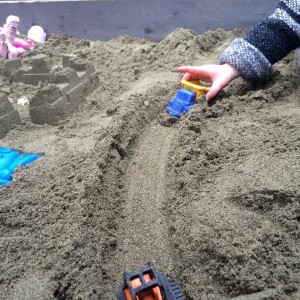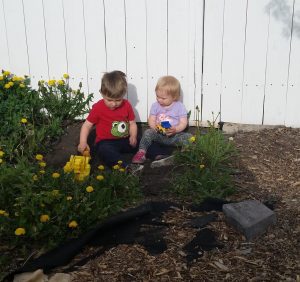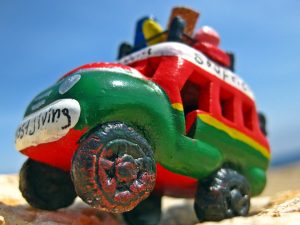A bus and a sandbox = bus sensory play. While this might be a simple formula for sensory play, it’s also two for one. Kids are not just exploring the sand, but also their own reactions and senses. There’s a lot happening on the outside and on the inside.

The wheels on the bus go round and round. In the sandbox or on the dirt pile they also go up and down and over. While the wheels go, so do the senses. Stimulation for the sense of touch is the most obvious. The sand, dirt, or rocks feel rough and cool. Besides the texture, there is resistance and children’s muscles respond. There’s interaction and feedback about what’s the right amount of force to use for pushing. A small bit of sand, dirt, or rock barely weighs anything, but a whole big amount is pretty heavy and dense. The sun, temperature, and air are also part of the touch experience.

Eyes are busy watching the bus and the hands. The wheels make patterns and lines in the sand. The sand, dirt, and rocks may not make much noise but ears are picking up sounds in the yard or neighborhood, like cars, people, birds, dogs, and more. If you want proof, just open something to eat in the house and notice how soon your child scurries inside. Hopefully, the sense of taste isn’t involved, but there may be smells of dirt and the immediate area.

Sensory play activates the brain. Young children often engage in this type of play. Brains are also solving-problems, testing ideas, observing, gathering information, planning, and creating connections and pathways. In EarlyChildhood News, Angie Dorrell writes, “Sensory experiences provide children with the opportunity to feel good about their decision-making skills – they control their actions and the experience. Self-discovery occurs as children become eager scientists.”

This sand + bus sensory play adds up to a great activity for brains and bodies. How do you rate this play-of-the-day?
